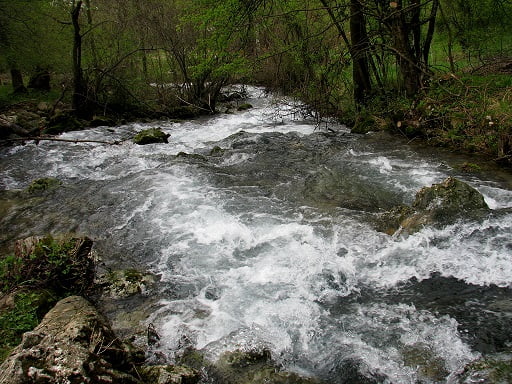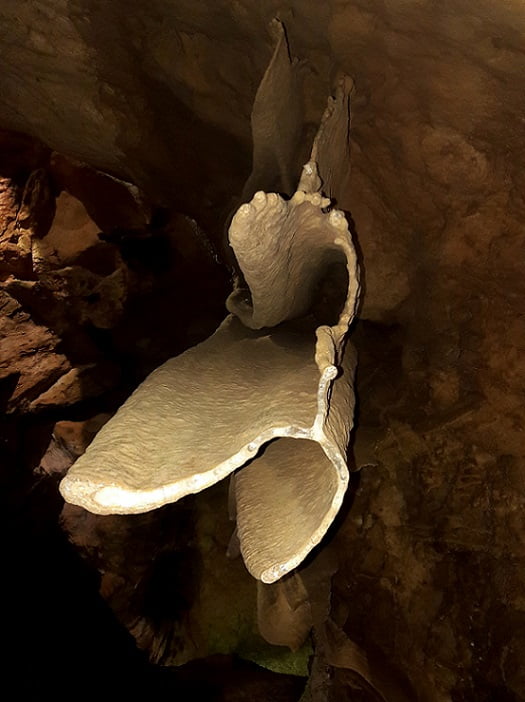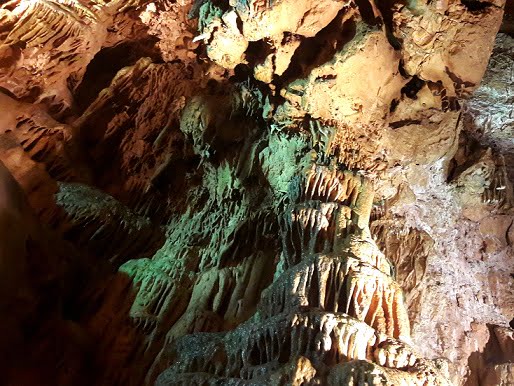
If you need a freelance travel writer or you would like to see your country, city, flight, etc., presented on the blog, drop me an email.
Find our more on Freelance Travel Writer page.
You may wonder why I have chosen the area around Despotovac Serbia as my first Serbian destination. I can almost hear the locals exclaiming: “It’s simple, we have everything here!” And you know what? They are absolutely right. So, let me take you through things to do in Despotovac Serbia.
Just look at the photo below—this is where I am right now, seated at a restaurant overlooking the lush, flowing waters. There’s no better spot to open my laptop and start typing the first lines of this new blog section, Things to do in Serbia, all while sipping local coffee, enjoying a hearty veal soup, and indulging in pancakes. The images of everything I’ve seen over the past few days are rushing through my mind—the breathtaking waterfall, intricate stalactites, rolling green hills, the 15th-century monastery walls, and the original stone floor at Manasija Monastery where Serbia’s great rulers once walked. But let’s start at the beginning.

Did you know it only takes a two-hour drive to reach Despotovac Serbia from either the capital city of Belgrade or Niš in the south? Stay tuned as I guide you through this enchanting part of the country, accompanied by vivid photographs that will show you just how easy and rewarding it is to stop by.
FROM BELGRADE: About 130 km (take the highway to Markovac – 100 km, and turn to Svilajnac town)
FROM NIŠ: About 115 km (take the highway to Ćuprija – 95 km)
Take the highway exit at Markovac town toward Svilajnac, and you’ll find Despotovac Serbia is easy to reach from there—just follow the road signs. I didn’t even need navigation and arrived without a single wrong turn.

Initially, my plan was just to drive through Despotovac on my way to the Manasija Monastery and spend a couple of hours exploring the town later. However, even a glimpse of its streets piqued my curiosity. I passed a quaint park and a charming pedestrian area on my left, and I thought, “This is where I’ll stop for coffee later.”

Manasija Monastery
The monastery was fortified with strong walls, including 11 towers, and was built by the Serbian ruler Despot Stefan Lazarević. The medieval scholar Constantine the Philosopher wrote that the construction work started in 1407, and it is assumed that the monastery was completed in 1418. It soon became the cultural center of medieval Serbia thanks to Despot Stefan, who realized the importance of preserving knowledge and thus established the Resava School here, dedicated to copying and preserving valuable books. For this reason, the monastery is also referred to as the Resava Monastery.
Despot Stefan Lazarević died in 1427 after suffering a heart attack while hunting near the town of Kragujevac. It remains uncertain whether his body is buried in Manasija or the Koporin Monastery near Velika Plana.

It’s easy to go around the town of Despotovac and hit the right turn toward Manasija, though signs tend to be small and hard to read, so take it slow to ensure you’re heading to the correct monastery (there are several in the area).

The road winds up and down over numerous hills, beautifully covered in forests and meadows. (I was lucky everything turned so green so quickly, thanks to the sudden rise in temperatures.) Another curve, another hill, and suddenly—you see the walls! The fortress is so imposing in all its medieval strength, creating a stark contrast to the green surroundings. An iron gate, a small parking lot, and an arched entrance between two enormous pillars welcome you to the Manasija Monastery – a must-see in Despotovac Serbia.

At the time I was there, two groups were arriving—one of primary school children and another of elderly citizens, hand in hand, buying candles. It’s not the first time I’ve visited Manasija, but I found myself wandering around the Resava School walls again, taking countless photos, and trying to shield myself from the sun to glimpse the church’s top. They say the floor inside the church is original—the same one placed when the complex was first built. I stepped up and down on it, one foot after another, thinking, “Oh, they walked here six centuries ago!”

Since a few blog friends suggested places in the area for me to explore, I drove further to the village of Lipovica, about 20 km from the monastery. The pleasant road is rarely traveled, so all the hills and curves seemed like they were there just for me.
I passed a charming bridge in the village of Bukovac, then entered the village of Panjevac, passing a few signs for local attractions. It seems the area now offers more to visitors. This was also a great opportunity to meet with people of the Eco Farm Milanović, to have a chat over a coffee.

Despotovac Serbia
The town lies between the Kučaj mountain and lush meadows on the east side of the Great Morava river. Although the entire municipality consists of 31 villages with over 23,000 inhabitants, the population of the town itself is less than 5,000 people. The area is rich in nature and water, with the Resava river winding its way through the region.
Despotovac was first mentioned in 1381 in a charter by Lazar, the Serbian monarch, but it wasn’t until 1882 that it got its current name. Serbian ruler Milan Obrenović decided to commemorate Despot Stefan Lazarević by naming the town after him.

Honestly, up until recently, I hadn’t thought much about the name of Despotovac. The realization came to me as I was trying to take another photo of the Despot Stefan monument at the square dedicated to this famous ruler. When you stop and reflect, it becomes clear how deeply the town’s identity is tied to its history—almost everything here is named either Resava or Despot, whether it’s a bank, a park, or even a dental clinic!

Still, Despotovac is a charming, small town worth exploring. You can visit the Old Mill, enjoy a coffee at the Despot’s Square, or admire the beautiful façade of the local library. And, of course, I couldn’t leave without indulging in some local cake—a sweet conclusion to my stroll through the town.

Veliko vrelo Lisine
The village of Lisine is nestled in the wider canyon of the Resava river at an altitude of 376 meters. Beneath the towering Beljanica mountain (1,300 meters), you’ll find Veliko vrelo (the Great Spring), whose waters cascade into the Veliki buk waterfall just a few hundred meters downstream. Veliko vrelo is one of the few strong karst springs in Serbia, and local nature enthusiasts proudly point out that it is a prime example of a gravitational spring. The small Vrelo river flows into the larger Resava, adding to the area’s natural charm. (There is another river Vrelo in Serbia, check out the Tara Mountain post.)
Lisine is also home to a fishpond and is famous for its unique species of trout.

It’s relatively easy to get here from Despotovac to visit the natural park of Lisine—a must-see if you’re in the area! However, I decided to make a slight detour toward Manasija first, before returning “to the traffic light and taking the left turn afterward.” About 15 kilometers later, you’ll reach a small crossroad that leads either to the Veliki buk waterfall or the Resava Cave.
“The waterfall first; the Cave can wait until tomorrow,” I told myself.

The road leading here isn’t in the best condition, so it’s wise to drive slowly to avoid the many potholes. Also, don’t forget to call your loved ones before reaching the hill because you’ll lose phone signal in this wild and untouched area. Truly, it’s genuine wilderness.

What I hadn’t done on my previous visit—and had promised myself to do this time—was to drive all the way up to the end of the paved road. This led me above the waterfall, right between Veliko Vrelo and the Veliki Buk. There’s a convenient parking lot here, and from there, it’s just a short 300-meter walk to the right.
I was blown away by Veliko Vrelo! The spring was brimming with life, with fresh, clean water tumbling down beneath a quaint wooden bridge and rushing over countless stones. The abundance of water, the serenity, and the sheer beauty of the surroundings made it an unforgettable experience. What a walk!

Veliki Buk
“This is a unique phenomenon among the karstic waterfalls in Serbia,” states the Despotovac municipality’s website. At around 25 meters in height, Veliki Buk is one of the largest waterfalls in Serbia. What makes it even more remarkable is that the waters descending from Veliko Vrelo have carved a deep basin into the slopes of the Beljanica mountain, creating a small lake a few meters deep. Together with the Vrelo river, the waterfall is part of the protected Natural Monument Lisine. The river Vrelo gathers mountain waters from the karstic areas of Beljanica, adding to its natural charm.
After enjoying the walk around Veliko Vrelo, the path continues downhill to Veliki Buk. This is where you’ll eventually return to pick up your car, and it’s also an excellent spot to take a break at Kafana Izvor Lisine, the local restaurant known for its traditional hospitality and generous portions. I even spent a night here (here is the link for the accommodation). You can also choose other privately owned houses and villas in the surroundings. It’s always better to be surrounded by nature if possible, especially if you’re coming from the city like me.

Go carefully, one step at a time, along the fenced path, watching the clear mountain waters cascade down from one level to the next. The improvised steps lead you downwards, and you can pause along the way to marvel at the scenery. When you reach the base, there’s a large garden area belonging to the restaurant to the left, while the path continues to the right, leading closer to the falls.
The roar of the water grows louder as you approach. It pounds over the rocks, sprays mossy surfaces, and fills the air with its foamy, misty presence. And then, the full view of the waterfall comes into sight. Oh! I was completely stunned, speechless—something rare for someone as full of life as I am.

Why was I so overwhelmed, given that this wasn’t my first time visiting Veliki Buk? The difference, I realized, was the time of year. During my last visit in the summer, the water levels were much lower due to the heat. But now, in April, it was as though the waterfall had awakened!
I remembered the small wooden terrace in front of the falls where I had posed for photos on a previous trip. This time, I couldn’t even get close. The waterfall was so loud, powerful, and full of life that it created gusts of wind, accompanied by a heavy spray that felt like rain bursting around me.

Although I visited other places in the region, I found myself returning to Veliki buk, unable to resist its captivating energy. I sat nearby to enjoy the view and typed these lines. By the time you’re reading this post, I’ll most likely already be back in Belgrade, but for now, it’s great to enjoy the this view while writing about Despotovac Serbia.

Resava Cave
The karst composition of the Beljanica mountain explains the abundance of pits and caves in this area. Among them, the most famous is the Resava Cave (also known as Divljakovac Cave). Not only is it the largest and most beautiful cave in Serbia, but it was also the second cave in the former Yugoslavia to open to the public.
This cave is an astounding 80 million years old. Stretching for 4.5 kilometers in total length, only 2,850 meters have been explored so far. Visitors, however, are allowed to explore a path 800 meters long, descending approximately 80 meters. The two accessible galleries feature striking formations such as the Hall of Joined Columns and the Entrance Hall of History—the latter being the site where remnants of a prehistoric fireplace were discovered.
The Resava Cave is open to visitors from April 1 to October 31, between 9 a.m. and 5 p.m., and you must be accompanied by a local guide during your visit.
Reaching the cave is straightforward. From Veliki Buk, head back to the same crossroad and take a left turn. The sign will clearly indicate that the Resava Cave is just 5 kilometers away. I joked with a friend I called after regaining mobile signal at the bottom of the hill: “I barely started the call, and I was already there!”

Make sure to bring a jacket or sweater, as the temperature in the cave is around 7°C, with humidity levels ranging from 80% to 100%.

Upon arrival, you’ll be informed of the next scheduled tour. Whether you’re alone or part of a large group, the tour will proceed as planned. My own visit began with just me and Igor, the local guide, who enthusiastically described the breathtaking halls. Eventually, another curious traveler from the U.S. joined us, and the two of us wandered through the cave, completely amazed. The natural decorations, the occasional bat flying by, and the mesmerizing sound of water droplets—all of it left us speechless. Being aware of the thousands of years it takes for those drops to form stalactites and stalagmites only adds to the wonder.

Outside the cave entrance, there’s a small area where you can grab a coffee, shop for souvenirs, or simply gaze at the surrounding forest. I found myself pausing there, inhaling the fresh mountain air, and releasing a few spontaneous sighs of contentment as my eyes took in the lush greenery.
With this visit complete, there was one more stop left for me in the Despotovac area. Back in the car, I drove toward Ćuprija, about 30 kilometers from Lisine, to visit another renowned monastery—Ravanica.

Ravanica Monastery
In 1375, the government of medieval Serbia decided to build an endowment for the monarch Lazar Hrebeljanović (Despot Stefan’s father). This monastery would not only serve as a spiritual and cultural hub but also as the monarch’s final resting place. The chosen site was a lush meadow near the river of the same name, beneath the Kučaj mountain. The monastery was fortified with strong walls and seven towers. Tragically, Lazar soon perished in the Battle of Kosovo, and over the centuries, Ravanica was frequently looted and damaged. Remarkably, the church itself remains in good condition, even though its valuables were taken long ago.
When invaders forced the monks to flee in the 17th century, they carried Lazar’s relics with them. At Saint Andrea, they built a small church and later reconstructed the Vrdnik Monastery in Fruška Gora, which earned the nickname “Little Ravanica.” The relics were eventually transferred to Belgrade’s Saborna Church. However, during the 600th anniversary of the Battle of Kosovo, it was decided that Lazar’s relics would finally return to Ravanica Monastery, where they now rest.

If you enjoy scenic drives, the road to Ravanica is a treat. You’ll pass through small forests, curve around lonely houses, and descend into the village of Senjski Rudnici. After about 10 more kilometers, you’ll reach the gates of Ravanica.

As with Manasija Monastery, you’re welcomed by imposing fortification walls. Inside, the church is adorned with authentic frescoes, including one of Lazar himself. Visitors are often curious to buy herbal mixtures and potions prepared by the nuns, and you can pick up a small souvenir “with the blessing of Saint Prince Lazar.” Standing there, it’s impossible not to imagine that this iconic Serbian leader once walked these same grounds, six centuries ago!

For those planning their next destination, the highway is just 10 kilometers from the monastery, providing easy access to towns like Ćuprija, Belgrade, Novi Sad, or Niš to the south.
…Now, forgive me for a brief digression—I must share a moment from my surroundings as I type these lines near Veliki Buk waterfall. A family with two small children just arrived at the restaurant. The youngest, a lively three-year-old girl, couldn’t keep still. Her father was feeding the baby while the pregnant mother repeatedly called the little one to return.

“Come back here; you can’t go there on your own,” the mother pleaded as the girl took another step, just behind me.
“But mom… You have to see this!”
“You can’t go there, please, come back,” the mother insisted.
“But mooom…”
Finally, the mother relented and asked, “What did you see?”
The girl, pointing excitedly to the waterfall, exclaimed, “Mom, come and see, please! There is… a huge fountain!”
Next destination – IRON GATE AND THE ROMANS
The full THINGS TO DO IN SERBIA section
PIN IT FOR LATER:
If you need a freelance travel writer or you would like to see your country, city, flight, etc., presented on the blog, drop me an email.
Find our more on Freelance Travel Writer page.
I am looking forward to working with you.




8 responses
I love both natural spots as well as city streets. The cobblestone street in one of your shots is simply awesome 🙂 Very interesting article, well done.
Thank you, so glad you like the post. Oh yes, this part of Serbia has really a lot to offer. I’ve enjoyed every minute of the journey. <3
I like the way your post is set up. It makes it very easy to read. Very interesting post about an area I am not very well educated about.
So glad it might come handy for first time visitors to learn more about this part of Serbia. Thank you for the kind words regarding the post’s layout, it means a lot. <3
This city is right my alley. Thank you for taking me on a trip through your beautiful pictures.
Thank you for traveling through my photos. 😉
For all the things that i red i see that this country is really interesting. I need to go there, and discover Depotovac 😉
You surely do. Let me know if you need any help. Thanks for stopping by. 🙂